Explicit topography design for complex shell structures based on embedded spline components
IF 5
2区 工程技术
Q2 MATERIALS SCIENCE, MULTIDISCIPLINARY
引用次数: 0
Abstract
The slender property of shell structures causes the magnitude difference between in-plane and out-of-plane stiffness. Inspired by such a geometry-induced anisotropy phenomenon, this paper proposes a novel design approach to improve the stiffness of complex shell structures. The optimization algorithm is constructed based on two technical pillars, i.e., the explicit moving morphable components (MMC) framework and the computational conformal mapping (CCM) technique. Owing to the MMC framework, the proposed approach can describe complex topography fields with local details via relatively few design variables, theoretically decreasing the computation burden. Towards shell structures in practice, of which the geometry models are usually flexible and complex, we leverage the CCM technique to parameterize the middle surfaces to obtain a unified and robust algorithm architecture. Representative examples with complex geometry models are provided to validate the proposed design method's effectiveness, efficiency, and universality.
基于嵌入样条构件的复杂壳结构显式地形设计
壳结构的细长特性导致其面内和面外刚度的大小差异。受这种几何诱导的各向异性现象的启发,本文提出了一种新的设计方法来提高复杂壳结构的刚度。该优化算法是基于显式移动可变形分量(MMC)框架和计算共形映射(CCM)技术两大技术支柱构建的。基于MMC框架,该方法可以通过较少的设计变量对复杂地形场进行局部细节描述,理论上减少了计算量。针对实际应用中壳体结构几何模型灵活复杂的特点,利用CCM技术对中间曲面进行参数化处理,得到统一、鲁棒的算法体系结构。以复杂几何模型为例,验证了所提设计方法的有效性、高效性和通用性。
本文章由计算机程序翻译,如有差异,请以英文原文为准。
求助全文
约1分钟内获得全文
求助全文
来源期刊
CiteScore
9.80
自引率
9.40%
发文量
276
审稿时长
52 days
期刊介绍:
The aim of Journal of The Mechanics and Physics of Solids is to publish research of the highest quality and of lasting significance on the mechanics of solids. The scope is broad, from fundamental concepts in mechanics to the analysis of novel phenomena and applications. Solids are interpreted broadly to include both hard and soft materials as well as natural and synthetic structures. The approach can be theoretical, experimental or computational.This research activity sits within engineering science and the allied areas of applied mathematics, materials science, bio-mechanics, applied physics, and geophysics.
The Journal was founded in 1952 by Rodney Hill, who was its Editor-in-Chief until 1968. The topics of interest to the Journal evolve with developments in the subject but its basic ethos remains the same: to publish research of the highest quality relating to the mechanics of solids. Thus, emphasis is placed on the development of fundamental concepts of mechanics and novel applications of these concepts based on theoretical, experimental or computational approaches, drawing upon the various branches of engineering science and the allied areas within applied mathematics, materials science, structural engineering, applied physics, and geophysics.
The main purpose of the Journal is to foster scientific understanding of the processes of deformation and mechanical failure of all solid materials, both technological and natural, and the connections between these processes and their underlying physical mechanisms. In this sense, the content of the Journal should reflect the current state of the discipline in analysis, experimental observation, and numerical simulation. In the interest of achieving this goal, authors are encouraged to consider the significance of their contributions for the field of mechanics and the implications of their results, in addition to describing the details of their work.

 求助内容:
求助内容: 应助结果提醒方式:
应助结果提醒方式:


